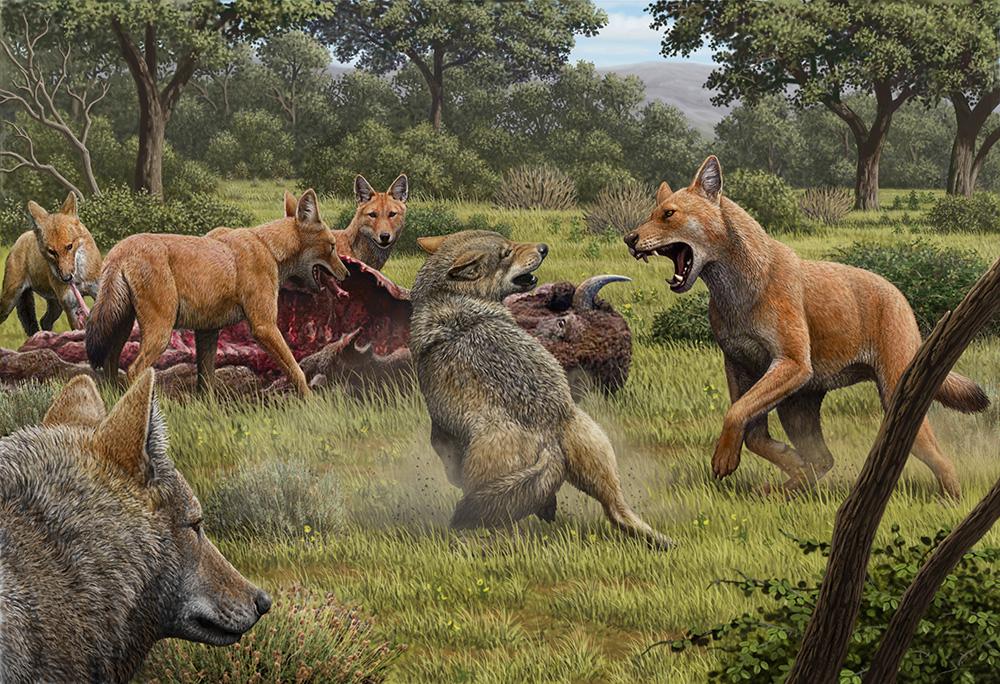Ancient DNA reveals secrets of Game of Thrones wolves

Somewhere in Southwestern North America during the late Pleistocene, a pack of dire wolves (Canis dirus) are feeding on their bison kill, while a pair of grey wolves (Canis lupus) approach in the hopes of scavenging. One of the dire wolves rushes in to confront the grey wolves, and their confrontation allows a comparison of the bigger, larger-headed and reddish-brown dire wolf with its smaller, grey relative. Artwork credit: Mauricio Antón/Nature.
Extinct dire wolves split off from other wolves nearly six million years ago and were only a distant relative of today’s wolves, according to new research published in Nature today.
Dire wolves, made famous in the TV show Game of Thrones, were common across North America until around 13,000 years ago, after which they became extinct.
The study shows that dire wolves were so different from other canine species like coyotes and grey wolves that they were not able to breed with each other. Previous analyses, based on morphology alone, had led scientists to believe that dire wolves were closely related to grey wolves.
The research was led by the University of Adelaide, Durham University in the UK, Ludwig Maximilian University in Germany, and the University of California Los Angeles in the US.
Now, for the first time, the international team has sequenced the ancient DNA of five dire wolf sub-fossils from Wyoming, Idaho, Ohio, and Tennessee, some dating back to over 50,000 years ago. Their analyses showed that dire wolves and grey wolves were in fact very distant cousins.
This is the first time ancient DNA has been obtained from dire wolves, revealing a complex history of these ice age predators.
The collaboration of 49 researchers across nine countries analysed the genomes of dire wolves alongside those of many different wolf-like canid species. Their analyses suggest that unlike many canid species who apparently migrated repeatedly between North America and Eurasia over time, dire wolves evolved solely in North America for millions of years.
Although dire wolves overlapped with coyotes and grey wolves in North America for at least 10,000 years before their extinction, they found no evidence that they interbred with these species. The researchers suggest that their deep evolutionary differences meant that they were likely ill equipped to adapt to changing conditions at the end of the ice age.
Co-lead author Dr Kieren Mitchell, from the University of Adelaide’s Australian Centre for Ancient DNA, said: "Dire wolves are sometimes portrayed as mythical creatures - giant wolves prowling bleak frozen landscapes - but reality turns out to be even more interesting.
"Despite anatomical similarities between grey wolves and dire wolves - suggesting that they could perhaps be related in the same way as modern humans and Neanderthals - our genetic results show these two species of wolf are much more like distant cousins, like humans and chimpanzees.
"While ancient humans and Neanderthals appear to have interbred, as do modern grey wolves and coyotes, our genetic data provided no evidence that dire wolves interbred with any living canine species. All our data point to the dire wolf being the last surviving member of an ancient lineage distinct from all living canines."
"Dire wolves are sometimes portrayed as mythical creatures - giant wolves prowling bleak frozen landscapes - but reality turns out to be even more interesting."Dr Kieren Mitchell, co-lead author, University of Adelaide
Co-lead author, Dr Angela Perri, from Durham University’s Archaeology Department, said: "Dire wolves have always been an iconic representation of the last ice age in the Americas and now a pop culture icon thanks to Game of Thrones, but what we know about their evolutionary history has been limited to what we can see from the size and shape of their bones and teeth.
“With this first ancient DNA analysis of dire wolves we have revealed that the history of dire wolves we thought we knew - particularly a close relationship to grey wolves - is actually much more complicated than we previously thought.
“Instead of being closely related to other North American canids, like grey wolves and coyotes, we found that dire wolves represent a branch that split off from others millions of years ago, representing the last of a now extinct lineage."
Co-lead author, Dr Alice Mouton, from the University of California Los Angeles, added: “The decreased cost of sequencing analyses in addition to state-of-the-art molecular biology methods for highly degraded materials allow us to recover DNA from fossils.
“Ancient DNA genomic analyses represent an incredible tool to better understand the evolutionary history of ancient and extinct species.”
The dire wolf is one of the most famous prehistoric carnivores from Pleistocene America which became extinct around 13,000 years ago. Known scientifically as Canis dirus, meaning ’fearsome dog’, they preyed on large mammals like bison. The team suggests the dire wolves’ stark evolutionary divergence from grey wolves places them in an entirely different genus - Aenocyon dirus (‘terrible wolf’) - as first proposed by palaeontologist John Campbell Merriam over 100 years ago.
Senior author, Dr Laurent Frantz, from the Ludwig Maximilian University of Munich, added: “When we first started this study we thought that dire wolves were just beefed up grey wolves, so we were surprised to learn how extremely genetically different they were, so much so that they likely could not have interbred. Hybridisation across Canis species is thought to be very common, this must mean that dire wolves were isolated in North America for a very long time to become so genetically distinct.”
Dire wolves became extinct around 13,000 years ago but thanks to fossil remains, DNA analysis, and a little bit of help from Game of Thrones, their legend lives on.
Dr Kieren Mitchell
Postdoctoral Researcher, Australian Centre for Ancient DNA, University of Adelaide
Mobile: +61 (0)437 846 528
kieren.mitchell@adelaide.edu.au
Robyn Mills
Senior Media and Communications Officer, University of Adelaide
Phone: +61 (0)8 8313 6341, Mobile: +61 (0)410 689 084
robyn.mills@adelaide.edu.au
